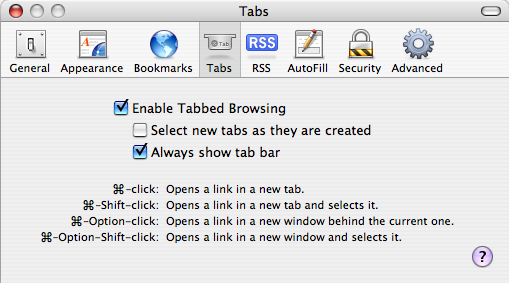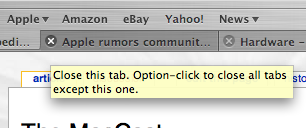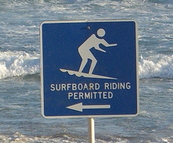![]() I’ve had a number of friends recently switch to Mac. They may have known how to use their Windows PCs well enough, but they weren’t what some may call “power users.” Having switched to the Mac, they’re finding themselves actually enjoying the use of their new computer, and wanting to know more. One of the first things I show them is some simple tips for browsing the web with Mac OS X’s built-in browser, Safari.
I’ve had a number of friends recently switch to Mac. They may have known how to use their Windows PCs well enough, but they weren’t what some may call “power users.” Having switched to the Mac, they’re finding themselves actually enjoying the use of their new computer, and wanting to know more. One of the first things I show them is some simple tips for browsing the web with Mac OS X’s built-in browser, Safari.
In our last Back to Basics, we explored how adding contacts to Address Book can add additional functionality to Safari.
This time, let’s look at some more basic features of the modern browsers that can dramatically improve your every day browsing.
Keyboard Controls
Using a mouse or track-pad is great, but sometimes there’s just no substitute for the good ole’ keyboard. Let’s look at the basic keyboard commands for simple browsing (note: there’s sometimes multiple ways to pull off a function):
New Browser Window: Command-N
Close Browser Window: Command-W
Back: Command-[ or Command-Option-left arrow key
Forward: Command-] or Command-Option-right arrow key
Reload Page: Command-R
Stop Page Load: Command-.
Skip to Next Link: Option-Tab
Skip to Previous Link: Option-Shift-Tab
Add a Bookmark: Command-D
Show Downloads Window: Command-Option-L
Increase / Decrease Font Size: Command-‘+’ / Command-‘-’ (without the quotes)
Skip between Address Bar, Search Box, and Webpage Fields: Tab
Tabs
Get ready, you’re about to enter the world of the power-user. Don’t worry, it won’t hurt a bit!
If you’re an avid web surfer (we still use that term, “surfer”, right?), you may find yourself with loads of open windows for different websites you’ve browsed to. Here’s a common scenario: you’re browsing a webpage that has some links you’re going to want to visit after you’re done reading the whole page. I don’t know about you, but what I used to do was right-click on the link, select “Open in new window” for each link, and then I’d have all these windows piled up. There’s a much more efficient way to keep your open websites organized, and that’s with tabs.
![]()
But much like the one-button mouse, Apple thinks life is simpler without tabs, by default in Safari, so, you’re going to have to enable them in the Safari Preferences (found either under the Safari menu or Command-,). Click on the aptly named “Tabs” icon, and you’ll see a few options and some helpful tips. First, check the first box to enable tabs. The second check box asks allows you to change focus to the new tab (until you get used to tabs, I’d leave this one unchecked for now). The third check box is a cosmetic issue—whether you want Safari to display tabs in a browser window all the time, or just when you have opened multiple tabs (if you’re running on an older or slower Mac, you may want to keep tabs shown all the time, because the animation that’s generated creating a tab can be painfully slow). Below all that, you get a number of helpful hints (btw—“click” just means the click of a mouse on a link on a webpage):

-
Command-click: open a link in a new tab, while keeping the focus on the current webpage.
-
Command-Shift-click: opens a link in a new tab and movesthe focus on that new tab.
-
Command-Option-click: opens a link in a new window, while keeping the focus on the current webpage.
-
Command-Option-Shift-click: opens a link in a new window and moves the focus to that new window.
Note: if in the Tabs preferences, you checked the second box, the above options will be different.

So, maybe you’re doing some research on your favorite Wikipedia article. As you read, you see links for other webpages that you know you’re going to want to browse to, but you’re not done reading this page yet. Even if you have the fastest ‘net connection, links sometimes take time to load, so you might as well start them a’loadin’ now. Just Command-click on the desired links, and you’ll see pertinent tabs with those pages popup next consecutively. When you’re ready, you can move over to those other tabs by clicking on them.

The webpage you loaded in that tab no good? Click on the little circle with an “X” in it.
Tab Keyboard Controls
Using the mouse can slow your newly-found tab efficiency. Keep those fingers on the keyboard! Sorry, those of you on desktops, you don’t have much of a choice, I guess. Anywho, here are some quick key commands:
New Tab: Command-T
Next Tab Right: Command-Shift-] or Command-Shift-right arrow key
Next Tab Left: Command-Shift-[ or Command-Shift-left arrow key
Close Current Tab: Command-W (when you have a browser window with only one tab, Command-W will close the whole browser window).
Upcoming Features
Tabs not dynamic enough for you? Want to reorder them? Want to split them into new windows or regroup them into one window? Want some of that lick-your-screen aqua animation goodness that Apple spoils us with?
Apparently, these features will be coming to a Safari browser near you soon with the next version of Mac OS X Leopard and Safari 3.0, at least according to some who are running developer copies of 10.5. You can see what I mean here. Check this out while you can—I’m not sure how long this preview will last as the video has already been taken down from YouTube.
Wrap-up
Well, this post got kinda lengthy, so I’m going to split these Safari browsing tips into at least two parts. Next up, RSS.






A “windows” friend of mine passed on a neat safari browsing tip. The big delete key next to the “+” will also serve as “BACK” when web browsing.
Jeff
Just keep in mind that the delete key only works as “back” if you don’t have focus in a text area.
It’s been always known to me, but a “power user” friend of mine didn’t know it, so I figured maybe some other geeks out there didn’t know it either.
Press the space bar (while outside text areas) and it will page down your current web page.